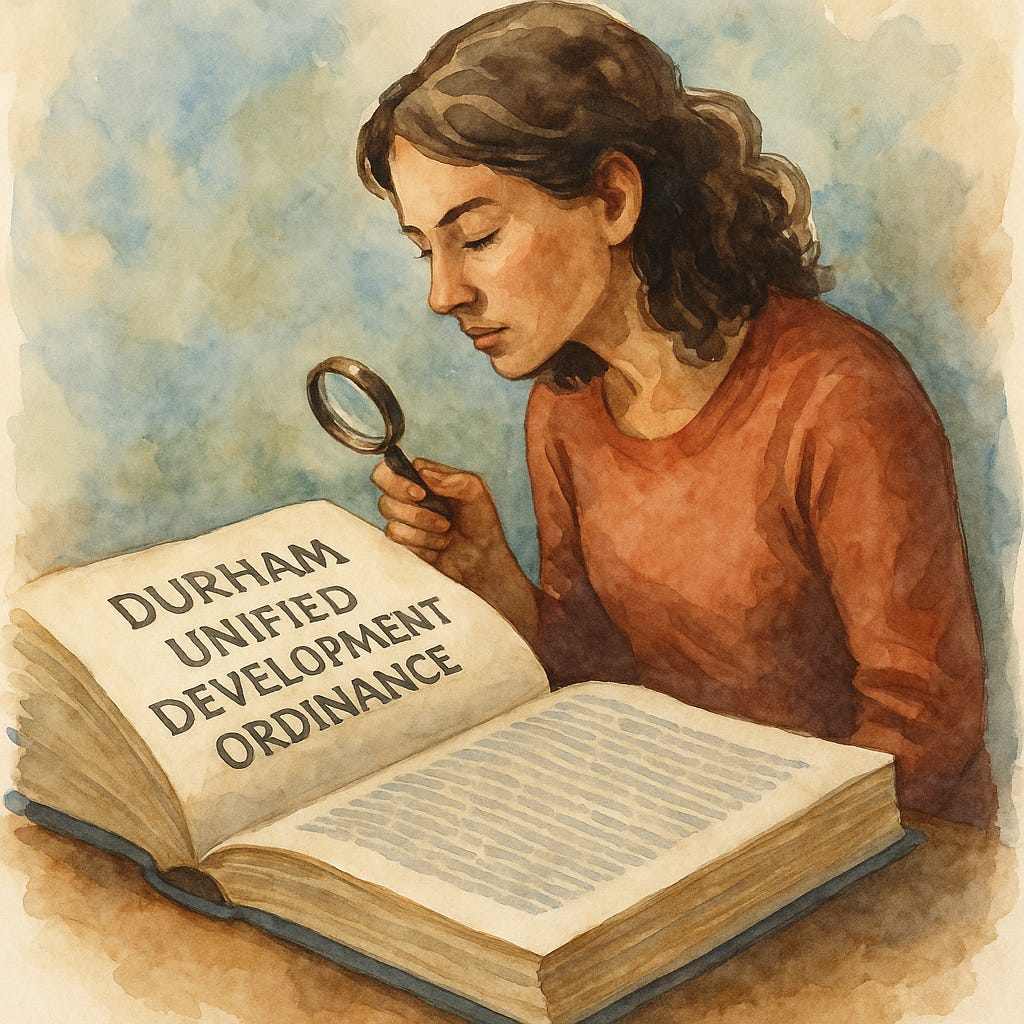Durham’s New UDO: Small Rules, Big Problems
From grading limits to parking rules, these details could make building smarter, denser neighborhoods nearly impossible.
Durham is in the process of rewriting its entire Unified Development Ordinance (UDO), the rules that govern housing, zoning, and development in our city. This post is part of a series examining specific aspects of the proposed code, and how we can make small changes that have meaningful impacts in the real world.
Other posts in our Durham’s New UDO series:

The next UDO may have the best intentions, but the details matter. We can envision better, more inclusive communities. We can strive for more walkable and resilient neighborhoods. But if a small detail trips up the type of development that Durham wants to see, we may keep getting more of the same: sprawling, exclusive, single-family housing. Crucially, the effects of those small but prohibitive policy details will never be uncovered, because we don’t have insight into why any given project did not move forward.
An example is the recent rule that you can’t grade within 5 feet of your property line. On a half-acre, single-family lot, that’s no problem. However, on denser infill sites where every foot matters, local builders will struggle to navigate this rule. A regulation that has great intentions is inadvertently telling builders that in Durham, constructing larger, single-family homes is just a whole lot easier than trying to add density and missing middle housing.

The proposed UDO has a ton of these “gotcha” rules that discourage dense development in favor of sprawl. We need to flip these. It should be easier to build small infill development and harder to build McMansions. While we won’t uncover some of these “gotchas” until we see how they operate in practice, it is up to us to anticipate as many as possible. CITYBUILDER has an ongoing list; below are just a few examples:
Places of Worship as Housing Providers
The proposed UDO reclassifies places of worship and other civic institutions under “CIV” zoning, which may mean that they can’t create housing! There is such great potential for these organizations (which have no profit motive) to create mission-based housing. They also have an abundance of under-utilized parking lots. This may be Durham’s best hope at affordable housing outside of federal Low-Income Housing Tax Credit (LIHTC) projects.
Finding the Right “Small Lot” Square Footage
If the proposed “R-D Option 3” zoning category is amended to include units of 800 square feet (sf) or less (see previous blog post), we should consider slightly bumping up the square footage for Option 2. On our current “Small Lots”, 1200 sf units have been great, but frankly, they exist in a middle ground. A “family starter” 3-bedroom house works much better at 1400 sf, while 800 sf houses would fulfill the starter home needs of small or emerging families. Not to mention, Durham is seeing a boom in inventory of houses that are exactly 1200 sf, and some variation in housing size at the small end would be welcome.
Unintended Consequences of Parking Design
While I completely understand the desire to keep cars out of the front yard from an urban design perspective, there is a tradeoff. Those rules mean longer driveways (that have to extend all the way to the back of the house), more impervious surfaces, and simply more space in our city dedicated to cars. The city could consider a rule that allows for extremely small front yard parking pads. Under such a scheme, total car use area could be limited to around 480 sf, and our city’s flood-prone streets would be better for it.

Site Plan Review Exemptions
Similar to the way that 5-foot no-grade buffers burden small infill more than sprawl, site plan review restricts development to larger projects. Site plan review (SPR) is a long, expensive process. It is simply not financially feasible for a tiny coffee shop or a handful of houses. Only developments that are ten times larger justify the time and expense of an SPR. So that’s what we get: big, expensive projects. Commercial and residential projects smaller than an acre in size should be exempt from SPR altogether.
For most of our code’s history, only single-family houses were exempt from site plan reviews. We gave preferential treatment to mansions over both missing middle housing and small commercial firms. If we want more small-scale, missing middle development in Durham, we need to start by putting it on equal footing with single-family homes.
Consistency with State Regulations
Stream buffers and their protection are important. Consistency is also important. The State of North Carolina sets robust stream buffer regulations based on research from the Department of Environmental Quality. The new UDO should align with NCDEQ buffers. Extra no-build zones and local buffers cause confusion and reduce housing while not aligning with the research and science provided by NCDEQ.
Final Thoughts
These details might seem technical, but they’ll decide how Durham grows for decades. If you’re a resident of Bull City, then you have the ability to shape our new UDO directly at a New UDO engagement session. Show up, talk to city planning staff about some of the policies we discussed today, and create a lasting impact on Durham’s growth! Thoughtful input today can prevent years of missed opportunity. We build better when we build together.
Dave Olverson is an incremental developer and zoning advocate in Durham, NC. He has an undergraduate degree in economics from Duke and a planning degree from the University of North Carolina. In 2021, he got his GC license and works specifically on infill projects in Durham.

